Hello! (Especially to my fellow Claremont parents!)
This is the longest blog post I’ve ever written but if you’re interested in homeschooling, it’s worth the long read. I say read it with a nice big cup of tea after the kids are in bed.
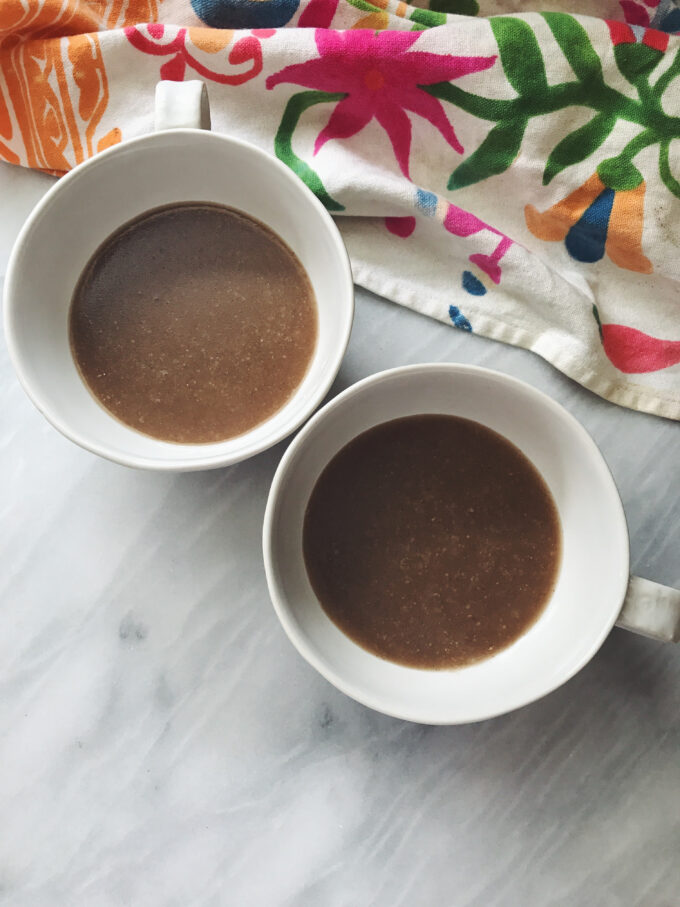
Or a cup of atole! We made this hot, sweet, corn-based drink when we studied the Ancient Maya
If you’re here for the first time you might notice I usually write about fashion on this page. But since the pandemic hit, my go-to outfit has been pajamas. I’m a mom to two bright girls (7, 2) so I’ve also been focused on my kids during these difficult times. A huge part of that has been supporting at-home learning. We live in a beautiful town with great schools, but even great schools were (and to some extent, remain) unprepared for providing high quality learning from a distance.
When I saw the school’s plan (worksheets mostly) back in March I knew I had to do better. So I started doing a lot of reading about homeschooling. This post is about what we did in lieu of what the school offered. Even now that our district has released its plans for the next year, I still think homeschooling might be the best option for us. Let’s start with some takeaways because I know if you’re a parent, you’re running low on time.
If you just want to know which curriculum I’m using, it’s A Gentle Feast. Listen, just check out the free preview on their site—that’s how our journey started. If you’re still interested, read on!
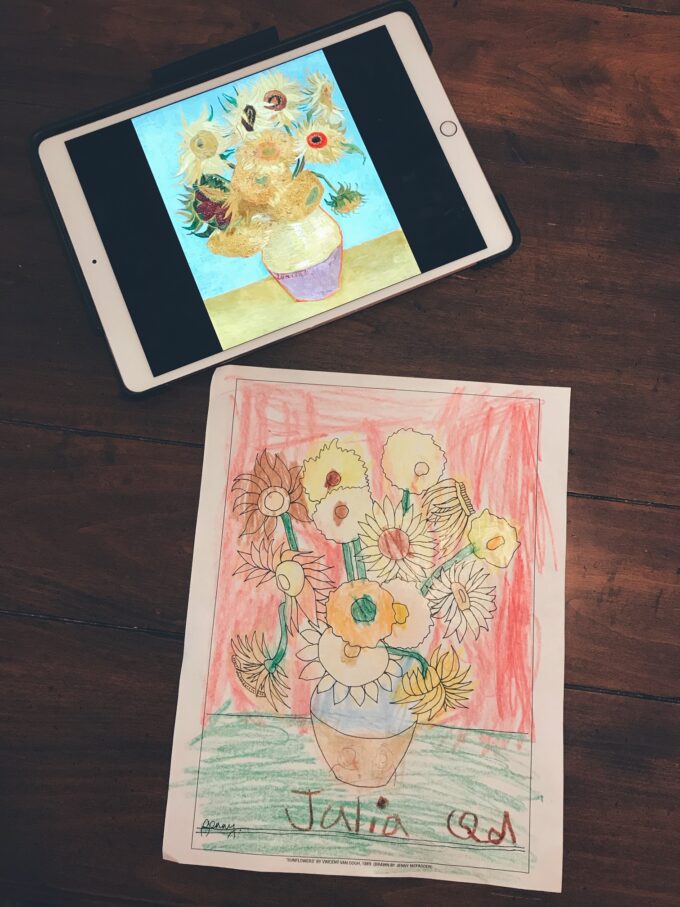
Sunflowers by Van Gogh and Julia
Big Picture Stuff
- Homeschool doesn’t take 6+ hours. For grade school kids you’re looking at 2-3 hours per day. Remember this is one-on-one instruction. Even if you have other kids, you don’t face the obstacle of group learning like you would if you were trying to teach a group of 25 kids.
- Homeschool is as affordable or expensive as you want it to be.
- Teaching at home is more about providing opportunities for your kids to discover and practice their skills. If they become more insterested in a subject, you can spend more time on it.
- Ask yourself, “What kind of learner is my child?” Visual, literary, hands-on, technical, artistic? Make the teaching reflect how they learn.
- Homeschool provides a child the unique opportunity to be taught to their strengths. Does your child need more time to write? You can provide that! Would they rather discuss the book than write a paragraph about it? You can do that! Would they rather write an essay about Van Gogh’s art than attempt to paint a still life of sunflowers? You can do that too! This isn’t to say we shouldn’t spend time on developing other important skills, but what if we really let their UNIQUE STRENGTHS shine?
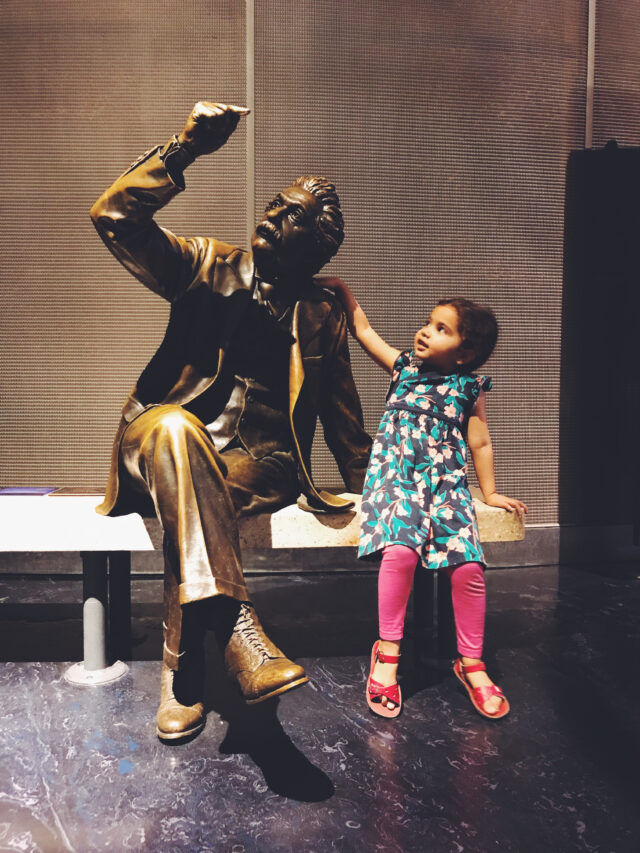
She’s always had a beautiful mind. An old pic with Einstein.
How Do I Get Started?
I know the first question for many is, “Can homeschooling work for my family?”
There are big decisions at play: can a parent be home to teach, is that partent patient/interested in learning (yep you! not the kids, at least not yet), what are ways both parents can support homeschool learning, can we afford it? Everyone has a different answer and in the end, the decisions we make in the best interest of our kids will look different and that’s OK!
I think the hardest thing for me was getting from “I’m interested in this…” to “I have the tools to begin.”
I looked to other homeschooling parents–there are many online who write about their experiences and I was lucky to follow some great ones on social media. I felt drawn to the Charlotte Mason method of homeschool, so that’s what I used as our base.
Charlotte Mason learning worked especially well for Julia. My soon-to-second-grader is very motivated by STORIES so she likes narrative, characters, who-what-where, and details. She likes to create so I provide ample opportunities for writing, painting, coloring, pasting, building. At its core, Charlotte Mason is about learning through literature.
For further reading, here’s a site that has a great summary of different homeschool philosophies.
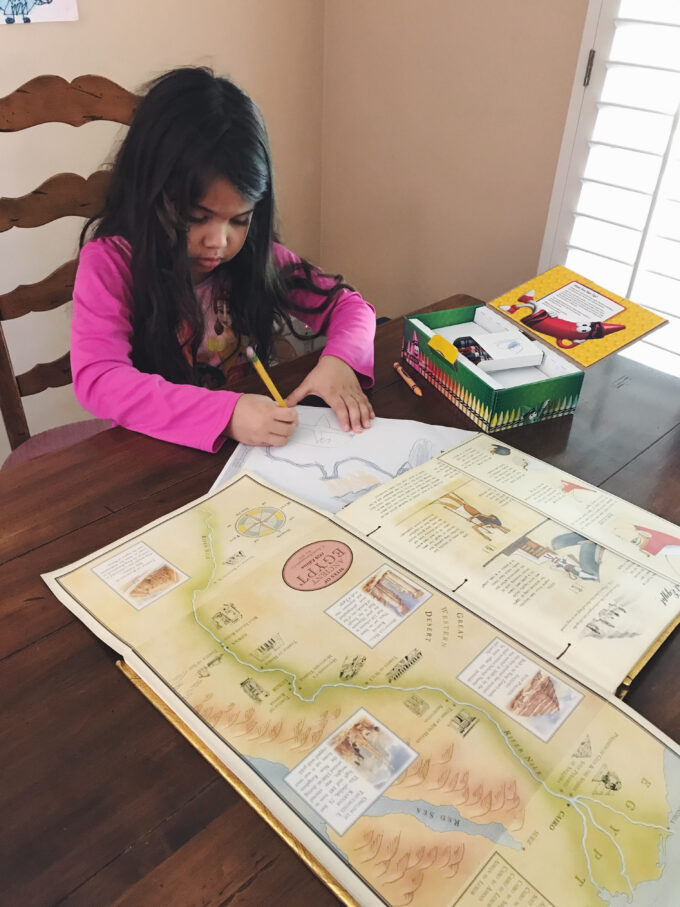
Ancient Egyptian scribe at work
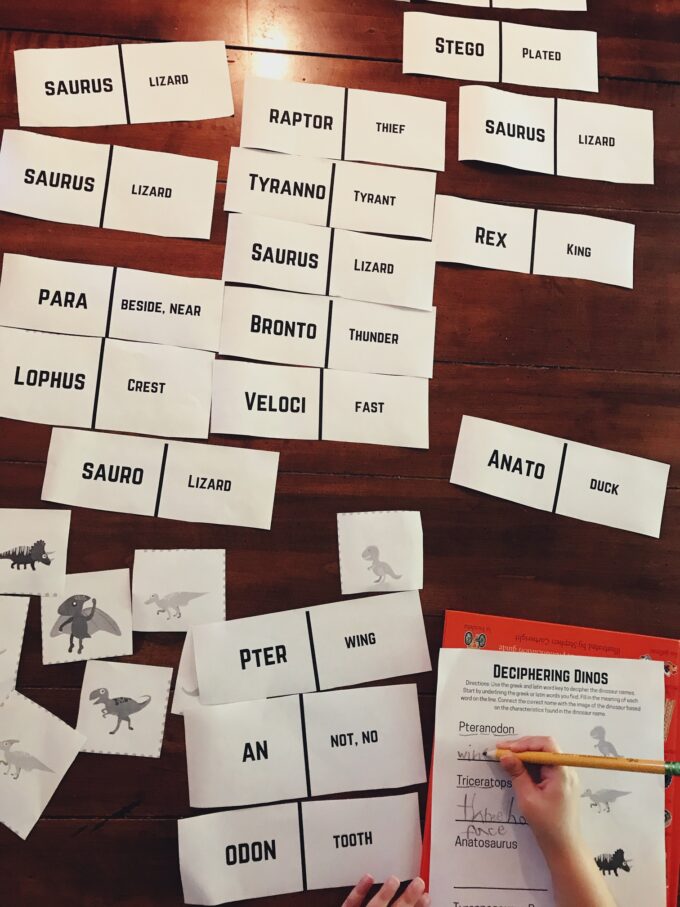
Greek and Latin meanings of dinosaur names
What I love about the Charlotte Mason approach
- We learn through literature; great books, poetry!
- It respects the gentle beauty of childhood
- It believes in exposing children to great art and music (we studied Botticelli and Vivaldi during our week dedicated to all things Spring.)
- It values learning about nature—for my daughter’s age we’re learning about butterflies, flowers, trees
- Kids practice writing through copywork—again, from great sources of literature
- Kids practice recitation by closely studying a poem or passage per week (which translates to public speaking & memory)
- It tests kids’ knowledge of subject through narration, something they practice every day throughout our reading
- No spelling tests
- It values developing real skills in arts and crafts. Weaving, woodwork, painting/drawing, etc.
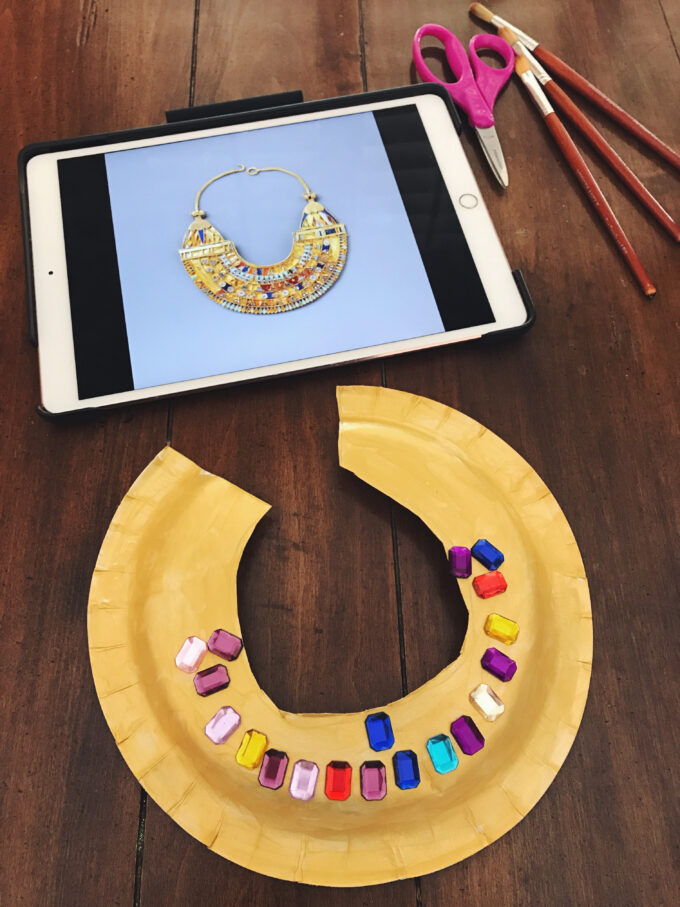
Pharaoh collar
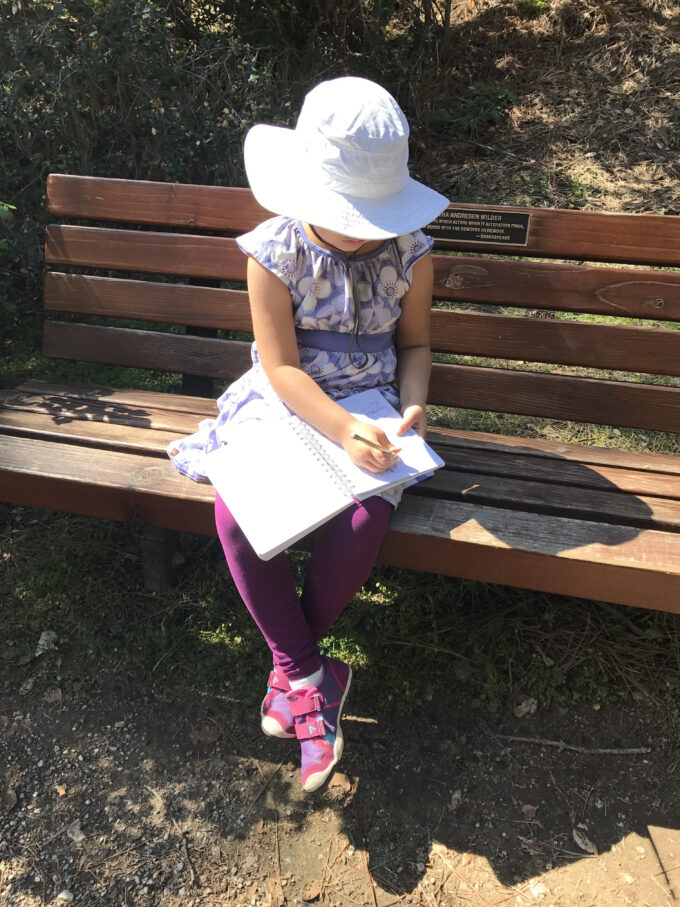
Nature study back in March pre-shutdown – Botanical Garden
How we made homeschooling our own
- We teach philosophy. One wonderful resource for this is Teaching Children Philosophy.
- We chose our own math curriculum. We went with Math U See. I love it much more than what our daughter had in school.
- We chose an overall homeschool curriculum but supplemented it with our own books.
- For PE, we do ballet and yoga videos on Youtube.
- I add fun crafts, cooking, or activities to pull themes together. Sometimes we stick to classic CM-activities (say, nature drawing) but sometimes we just have kid-led fun
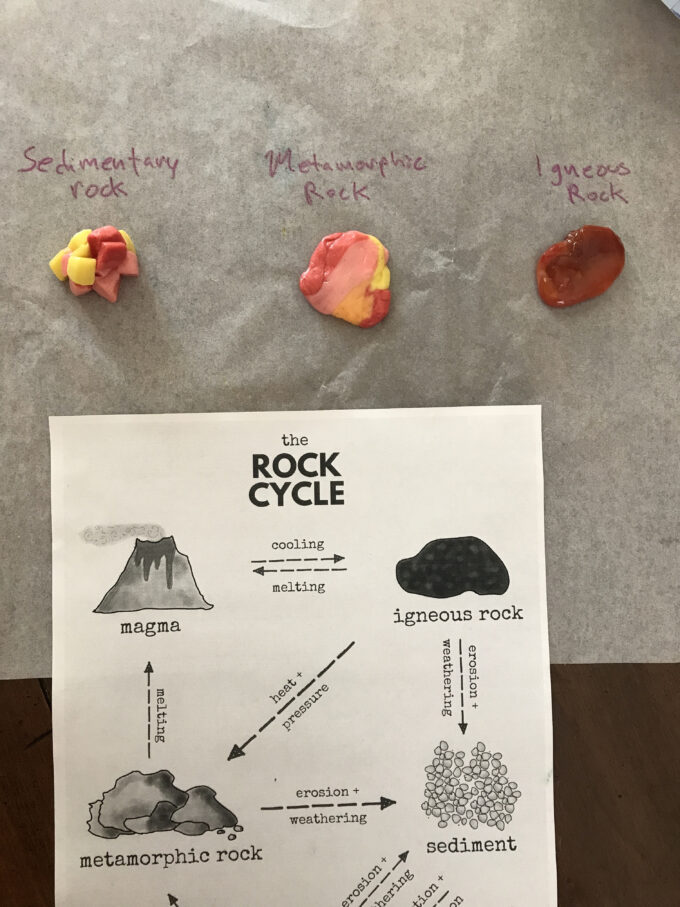
Starbursts were eaten this day
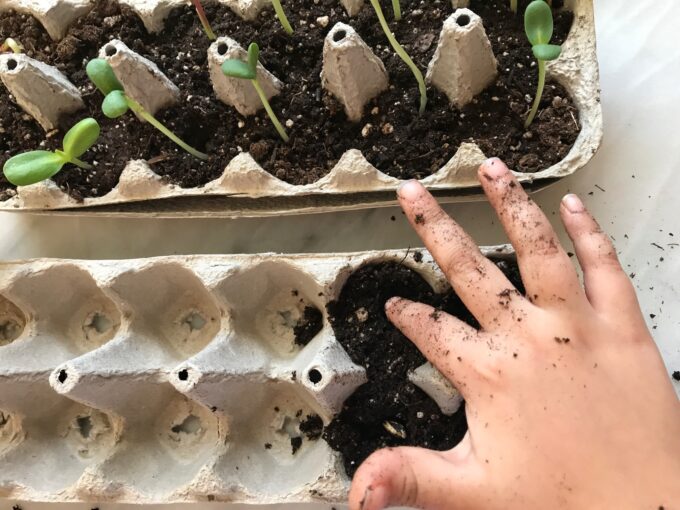
Taking care of seedlings
OK but what does your day actually look like?
Here’s our homeschool schedule!
- Breakfast
- Morning time: we study art or music (e.g. Botticelli painting, Vivaldi composition) – 10-20 min
- Language arts (writing, concepts, critical thinking) – 20 min
- Foreign language/nature study (alternating days) – 20 min
- History/Geography (alternating days) – 20 min
- Play or Yoga/Dance – 15 min
- Phonics & Reading – 20 min
- Math – 25 min
- Music/singing – 15 min
- Afternoon tea – we read aloud, something like a poem – time varies
- Quiet time/creative time – play, reading, or some kind of art project – time varies
Total school time (minus tea/lunch) ends up being about 2.5-3 hours.
Getting time outdoors is an essential part of CM philosophy. Personally I’d love a weekly trip to the Botanical Gardens. Pack the nature journal and water (and masks.) And just get some time outside.
We do school 5 days a week. Some families do longer days in order to have 4-day weeks. Also, please remember this is the schedule that works for our daughter’s age and includes our daughter’s interests. An older student would spend a bit longer on these subjects. Perhaps you trade nature study for biology, or trade Spanish for coding.
Help, I still don’t see how I would put together lessons!
I understand. Let’s say we’re studying Ancient Egypt for two weeks. We read literature and books about the time, set that as the theme for our writing and language arts, include the theme in our math (geometry), explore a new skill (map making) and create art inspired by the subject (pharaoh collars, pottery.) Again, the Charlotte Mason approach is about learning through literature. That means we use books a lot.
Is there a curriculum I can just buy?
Yep! There are lots of ways to homeschool but since I was new to this I needed some help. What would our days look like? Where do I start? What materials do I use?
After researching free and paid options, I chose A Gentle Feast. This curriculum costs $110 with printed materials or $85 for digital access. AGF provides a book list for you to obtain. There are quite a few but I got great deals on Thriftbooks. More on other things I bought further below.
Due to the many store closures it was hard to track down books back in March so I ended up just using the framework with my own themes and applied CM principles. Thus I ended up with units like Ancient Egypt, Ancient Maya, the Middle Ages, Earth Science, Springtime Gardening (we planted a garden!) In the fall we’ll be using the AGF curriculum entirely. We’ll be studying American history (starting with Native history through early Colonial times.)
Can you tell me more about the Charlotte Mason curriculum you’re using?
Yes! If you’re curious about A Gentle Feast, you can sign up for a preview of the curriculum on their site. I ended up buying it right away once I realized how organized and well-prepared everything was.
Another thing: AGF is suitable for kids of different grades. You do have to choose a cycle (historical period) to start with. There are 4 cycles in AGF. In theory you could do a different cycle every year you homeschool (eventually forming a loop) and the recommended materials would just keep progressing based on grade level up through high school. For instance, Julia might be reading a book about Galileo suitable for grade 1-2. An older student would be assigned a book about Galileo that is suitable to their grade within the same cycle.
There are a few places in AGF where I choose to use my own books rather than what the curriculum offers. Like I chose to spend more time on Native American history. It just means updating my google docs that have our weekly schedule all laid out.
Even though it’s not ~necessary to get a curriculum, having one makes me feel confident I KNOW WHAT TO DO. That feeling, combined with resources, made me EXCITED about homeschooling. The plans and schedules and list of materials are so helpful to have.
Another thing: our family is doing a secular version of AGF. That is, we don’t add the optional bible study. Morning Time is one of the loveliest parts of our day, so do consider keeping it in some form. Whether you get the optional Morning Time book is up to you. It does contain some hymns but also poems and great art selections (Da Vinci, Vermeer, etc.) However, you can do your own morning picture or music study, especially if you have an ipad or museum book handy. We also use spotify. The importance of morning time is setting the tone for your morning.
Tell me more about Homeschool costs?
Core curriculum
- A Gentle Feast curriculum $110 (printed)
- Literature assigned by A Gentle Feast: $150 – Amount will vary depending on your choices, e.g. I bought a hard copy of Aesop’s Fables but the resources link a free digital version. When there’s a free version it’s noted. It depends on your tolerance for screens during your day. We tend to prefer physical books.
Math + Phonics
- Math Book + Digital Lessons + Integer Kit: $180
- Phonics book + workbook: $70
- Well Trained Mind Language Lessons Book (stuff like parts of speech/grammar) $12
- Well Trained Mind Writing with Ease Book (for when I want to mix up the copywork) $22
Interests + Fancy Extras (Depends on you!)
- MET museum book for picture study: 50
- Children’s poetry books: $35
- Cartography book: $25
- Coding book: $15
- Native American history books: $50
- Classical Music Enrichment book: $10
AGF doesn’t include its own math or phonics so it’s up to you to choose, though the curriculum makes some recommendations. I already mentioned the Math U See curriculum. We will use this excellent phonics book by a company called Barefoot Meandering. What I love about it is that it teaches spelling skills without spelling tests. It might seem a bit intense since you’re teaching 75 phonograms over time. But everything I read about it suggests it creates a super strong foundation for reading and spelling skills.
Of course there’s also stuff like paint, paper, craft supplies, journals, pencils.
What’s the most affordable way to do this?
IN ALL HONESTY if cost is a big issue, I say don’t buy any curriculum.
Instead, start your research using free resources. There is extensive info on Ambleside and Wildwood. You will have to put in time to develop your own book list, core materials, and such. The library in our town is still doing curbside pickup so I do think there’s a way to maximize free books, especially if you aim for about 3 weeks of books at a time. Of course this is premised on the library staying open throughout the school year (which I truly hope for.) Beyond that, you will still need something for math and language arts.
For stuff like core materials, like Charlotte Mason-style language arts textbooks, check out Rainbow Resource, it’s a homeschooling shop with a gazillion options to suit any homeschool. That link is just to CM curriculum books but there is SO much on that site. Seriously my newest favorite place to browse and shop.
If cost is not an issue, you will like the fact that all that foundation work has already been done for you. Personally, I’ve combined resources from different sources but AGF is both the main source of resources and the framework for each day.
I think I need a drink…
Can I join you? Thinking about next year makes me feel all the feelings. But homeschooling also makes me feel empowered. And even though we’ve been stuck at home, reading makes us feel like we’ve traveled through time and space. I really do feel like I’ve gone on a journey with my daughter. That’s why I wanted to write this super long post. In case there’s another mama out there who is thinking “I’m open to the idea” but doesn’t know where to start.
Here’s a bit of art just for you.

I know that feel – Metropolitan Museum of Art
What are some next steps or stuff to know?
A note about filing reqs.
If you’re going to homeschool in California you need to file what’s called a Private School Affidavit with the state. That means you become your own private homeschool. In California this needs to be done during October 2020. Please check your state requirements.
If you’ve read THIS FAR it might mean you’re super into the idea of really building something that is your own homeschool and I understand that because it’s what I’m going to do.
Wishing everyone a lovely summer of planning ahead.
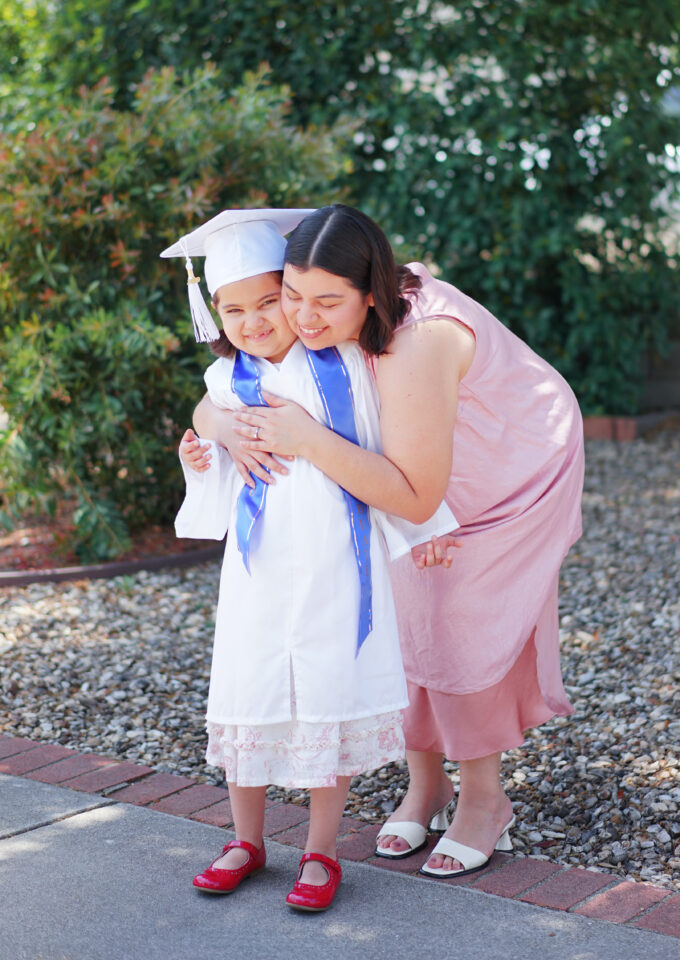
So proud of her. She learned so much last year.
Hey! This post contains affiliate links: if you buy AGF with my link I get a small percentage back, which I will likely use to buy more books! Please know I have purchased everything here myself and recommend everything wholeheartedly. Thanks for your support!
If you are interested in more you can follow me on Instagram @pinklip.





